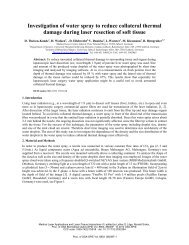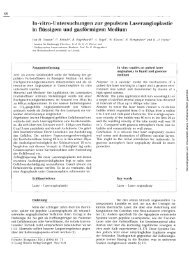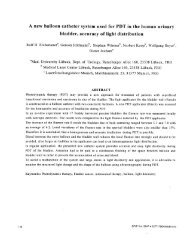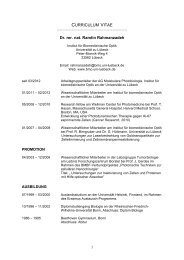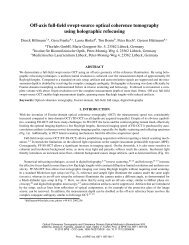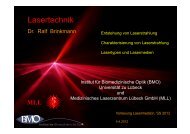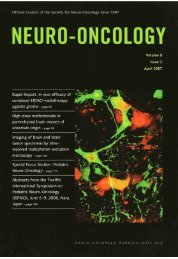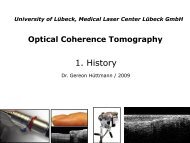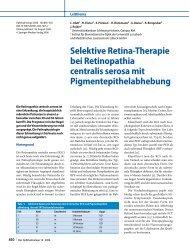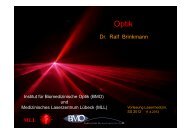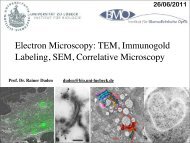Invited p aper Mechanisms of femtosecond laser nanosurgery of ...
Invited p aper Mechanisms of femtosecond laser nanosurgery of ...
Invited p aper Mechanisms of femtosecond laser nanosurgery of ...
You also want an ePaper? Increase the reach of your titles
YUMPU automatically turns print PDFs into web optimized ePapers that Google loves.
1040 Applied Physics B – Lasers and Optics7.2 Femtosecond pulses at kHz repetition rates withenergies above the bubble-formation thresholdWhen pulse trains <strong>of</strong> 1-kHz repetition rate are employedfor <strong>nanosurgery</strong>, pulse energies in the range 2–40 nJare used [79, 83–85]. Examples are the ablation <strong>of</strong> single mitochondria(8) by several hundred 2-nJ pulses [85] and thesevering <strong>of</strong> axons in a live C. elegans worm (9) with a similarnumber <strong>of</strong> 10-nJ pulses [79]. These energies are above thethreshold for thermoelastically induced formation <strong>of</strong> minutetransient cavitation bubbles (6), and are thus associated withmechanical disruption effects. The tensile thermoelastic stresswaves enable dissection <strong>of</strong> cellular structures at low volumetricenergy densities, and the small size <strong>of</strong> the heated volume(Fig. 8) correlates with a radius <strong>of</strong> the expanded bubble <strong>of</strong>the order <strong>of</strong> only 120–300 nm (Fig. 20). This explains whyfs-<strong>laser</strong>-induced bubble formation does not necessarily leadto cell damage whereas ns-<strong>laser</strong>-induced bubble generation isusually associated with cell death [61, 189, 190, 192, 206].Due to the contribution <strong>of</strong> mechanical effects to dissection,the total energy required for <strong>nanosurgery</strong> with kHz pulseseries is less than the total energy necessary with MHz pulsetrains. For example, ablation <strong>of</strong> a mitochondrion using 1-kHzpulses required a total energy <strong>of</strong> less than 1 µJ [85], while forintranuclear chromosome dissection with 80-MHz pulses anenergy <strong>of</strong> 15 µJ was needed [4].For sufficiently large pulse energies, bubble expansion andshock-wave pressure can cause effects far beyond the focalvolume, which lead to cell death [83, 198, 207]. To avoid unwantedside effects, irradiances should be used that are onlyslightly above the bubble-formation threshold. Useful techniquesfor an on-line monitoring <strong>of</strong> the ablation thresholdduring <strong>laser</strong> surgery are to detect the onset <strong>of</strong> photobleaching,or <strong>of</strong> light scattering by bubbles generated at the <strong>laser</strong>focus. Heisterkamp et al. found that the threshold for photobleachingis just below the ablation threshold [84]. Neumannand Brinkmann described a light-scattering technique for anon-line detection <strong>of</strong> micrometer-sized bubbles produced bypulsed <strong>laser</strong> irradiation [208].We conclude that, depending on the repetition rate <strong>of</strong> thefs <strong>laser</strong> pulses, <strong>nanosurgery</strong> relies on two very different mechanisms.With oscillator pulse trains at MHz repetition rates,dissection is due to accumulative chemical effects in lowdensityplasmas. In this regime, no transient bubbles withsub-microsecond lifetime are produced, and the formation <strong>of</strong>long-lived bubbles by accumulative chemical and thermal effectsmust be avoided. With pulse trains at kHz repetitionrates, the accumulative creation <strong>of</strong> chemical effects wouldtake too long to be practical. Therefore, the pulse energies areraised to a level where the thermoelastic generation <strong>of</strong> minutetransient bubbles enables us to achieve nanodissections. Dueto their short lifetime <strong>of</strong> less than 100 ns and the long time intervalsbetween the <strong>laser</strong> pulses, no cumulative bubble growthoccurs as long as pulse energies close to the bubble-formationthreshold are used.7.3 Comparison with long-pulsed and cw irradiationIn their pioneering work, Berns et al. [69, 70]used high-power argon-<strong>laser</strong> irradiation in multiline operation(with wavelengths <strong>of</strong> 488 nm and 514 nm) applied in 25–30-µs pulses. Other researchers employed longer exposure times<strong>of</strong> 0.25 s [47] and 1 to 2.5s[52] at smaller <strong>laser</strong> power. Bernset al. [34] related the spatial extent <strong>of</strong> their <strong>laser</strong> effects simplyto the irradiance distribution in the focal region. However,with the exposure times used, the energy deposition is broadenedby thermal diffusion. For large numerical <strong>aper</strong>tures thefocal volume has an almost spherical shape, and the characteristicthermal diffusion time t d is approximately given as [124]t d = d 2 /8κ, (24)where κ is the thermal diffusivity and d the focal diameter.Thermal confinement <strong>of</strong> the energy deposition requiresthat the <strong>laser</strong> exposure is shorter than the thermal diffusiontime [2]. For a focal spot diameter <strong>of</strong> 480 nm in aqueous media(λ = 514 nm, NA = 1.3), this is the case only for <strong>laser</strong>pulse durations < 210 ns; for longer <strong>laser</strong> exposures such asused by Berns et al. [34] the temperature distribution is broadened.We have seen in Sect. 5.3 (Fig. 12) that the distributionclose to the focus center becomes stationary after about 10 µs.This implies that the spatial extent <strong>of</strong> effects from <strong>laser</strong> pulseslonger than 10 µs is similar to that <strong>of</strong> lesions arising from cw<strong>laser</strong> irradiation. Nevertheless, the temperature distribution isvery narrow even for cw irradiation, because from a pointlikesource the heat can diffuse in all spatial directions and,therefore, the temperature drops very quickly with growingdistance from the source.Effects created by long-pulsed or cw irradiation usuallyrely on linear (one-photon) absorption. For argon-<strong>laser</strong> irradiationat wavelengths <strong>of</strong> 488 nm and 514 nm that can be welltransmitted into a cell, the <strong>laser</strong> power needed for surgeryin unstained cells exceeds 1W [70]. It is thus considerablyhigher than the average power <strong>of</strong> about 30 mW necessary with<strong>femtosecond</strong> <strong>laser</strong> pulse trains at 800 nm [4, 37], for whichplasma formation induced by the ultra-short <strong>laser</strong> pulses resultsin a dramatic local increase <strong>of</strong> the absorption coefficientat the focus, regardless <strong>of</strong> the linear absorption coefficient.Berns et al. speculated that high-power argon-<strong>laser</strong>cell surgery is most likely a multiphoton mechanism [34].However, even though two-photon-excited visible fluorescencewas observed in experiments with a 760-nm cw <strong>laser</strong>beam [209], multiphoton absorption is unlikely to be the dominantabsorption mechanism considering the fact that the focalirradiance for 1-W <strong>laser</strong> power (5.5 × 10 8 Wcm −2 is threeorders <strong>of</strong> magnitude less than the irradiance required for intracellulardissection with 800-nm, 170-fs pulses. The focal irradianceused for quasi-cw cell surgery is also much lower thanthe irradiances used for multiphoton microscopy [210, 211].Thus, there is little doubt that quasi-cw cell surgery is basedon the linear absorption in the target structures, whereas ultrashort-pulsedsurgery relies on nonlinear absorption.It was shown above that no purely thermal effects can beproduced using ultra-short <strong>laser</strong> pulses. All thermal effectsare accompanied by free-electron-mediated chemical effectsand thermoelastic mechanical effects. By contrast, quasi-cwcell surgery is mediated by local thermolysis and the formation<strong>of</strong> minute vapor bubbles. The temperatures required forthermolysis depend on the heat-exposure time [212], and arewell above 100 ◦ C for heat-exposure durations in the millisec-



